Comparisons of the Synoptic Characteristics of 14-Day Extreme Precipitation Events in Different Regions of Eastern China
Abstract
1. Introduction
2. Data and Methods
2.1. Data
2.2. Analysis Domains
- (a)
- North China (NC); includes areas within 36.5° N–40° N, 110° E–117° E.
- (b)
- the Yangtze River valley (YRV); includes areas within 26.5° N–31° N, 115° E–120° E.
- (c)
- South China (SC); includes areas within 21.5° N–25° N, 110° E–117° E.
2.3. Defining 14-Day Extreme Precipitation Events
2.4. Compositing Methods
3. Characteristics of 14-Day Extreme Precipitation Events
3.1. Synoptic Composites
3.1.1. Average 500 hPa Geopotential Height Standardized Anomalies
3.1.2. Total Event Composite of 200 hPa Zonal Wind Standardized Anomalies
3.1.3. Total Event Composite of Standardized Integrated Vapor Transport (IVT) Anomalies
3.1.4. The Total Event Composite of Standardized Potential Pseudo-Equivalent Temperature Anomalies
3.2. Trough–Ridge Patterns
3.2.1. Indices for Standardized Geopotential Height Anomalies in Trough and Ridge Maxima Regions
3.2.2. Percentage of Occurrence of Trough and Ridge Days for Event and Nonevent Days
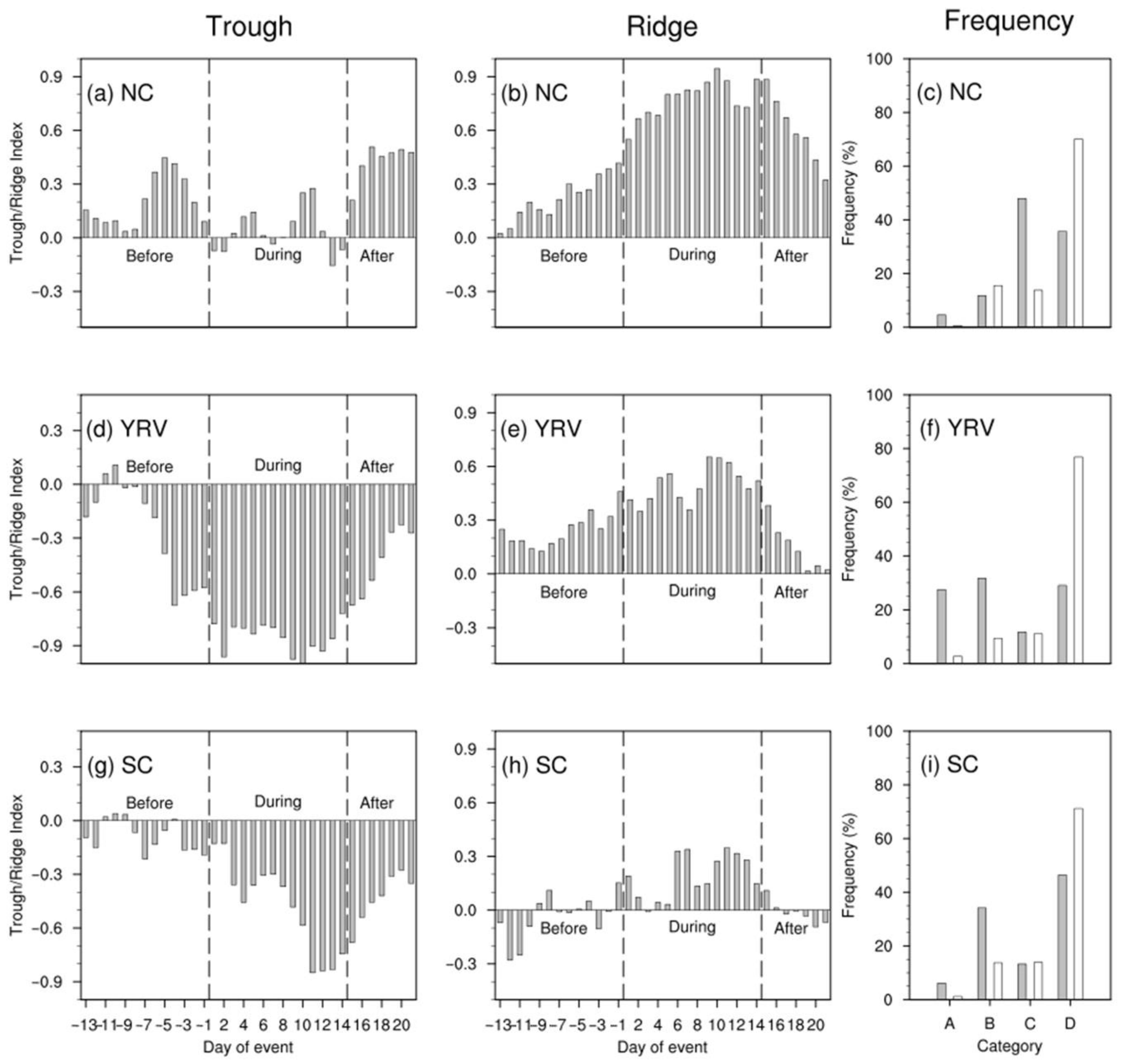
3.3. Atmospheric Rivers
4. Precursors to 14-Day Extreme Precipitation Events
4.1. Synoptic Lag Composites
4.1.1. Standardized 500 hPa Geopotential Height Anomalies Lagged Composites
4.1.2. Standardized 200 hPa Zonal Wind Anomalies Lagged Composites
4.2. Modes of Climate Variability
5. Summary and Conclusions
Author Contributions
Funding
Institutional Review Board Statement
Informed Consent Statement
Data Availability Statement
Acknowledgments
Conflicts of Interest
References
- Chen, D.L.; Ou, T.H.; Gong, L.B.; Xu, C.Y.; Li, W.J.; Ho, C.H.; Qian, W.H. Spatial interpolation of daily precipitation in China: 1951–2005. Adv. Atmos. Sci. 2010, 27, 1221–1232. [Google Scholar] [CrossRef]
- Bao, M. The statistical analysis of the persistent heavy rain in the last 50 years over China and their backgrounds on the large scale circulation. Chin. J. Atmos. Sci. 2007, 31, 779–792. (In Chinese) [Google Scholar]
- Zhai, P.M.; Ni, Y.Q.; Chen, Y. Mechanism and forecasting method of persistent extreme weather events: Review and prospect. Adv. Earth Sci. 2013, 28, 1177–1188. (In Chinese) [Google Scholar]
- Yu, R.C.; Wang, B.; Zhou, T.J. Tropospheric cooling and summer monsoon weakening trend over East Asia. Geophys. Res. Lett. 2004, 31, L22212. [Google Scholar] [CrossRef]
- Yu, R.C.; Zhou, T.J. Seasonality and three-dimensional structure of interdecadal change in the East Asian monsoon. J. Clim. 2007, 20, 5344–5355. [Google Scholar] [CrossRef]
- Zhou, T.J.; Gong, D.Y.; Li, J.; Li, B. Detecting and understanding the multi-decadal variability of the East Asian summer monsoon—Recent progress and state of affairs. Meteorol. Z. 2009, 18, 455–467. [Google Scholar] [CrossRef]
- Tao, S.Y. The Torrential Rain in China; Science Press: Beijing, China, 1980; p. 225. [Google Scholar]
- Ye, D.Z.; Zhu, B.Z. Some Fundamental Problems on General Circulation of Atmosphere; Science Press: Beijing, China, 1958; p. 159. [Google Scholar]
- Tao, S.Y. A synoptic and aerological study on a cold wave in the far east during the period of the break down of the blocking situation over Euroasia and Atlantic. Acta Meteorol. Sin. 1957, 28, 63–74. [Google Scholar]
- Zhang, J.J. A qualitative analysis on the activity of the ultra-long wave. Chin. J. Atmos. Sci. 1979, 3, 99–108. [Google Scholar]
- Tao, S.Y.; Zhang, X.L.; Zhang, S.L. Study of Meiyu Front Induced Storm Rainfall along the Yangtze River; China Meteorological Press: Beijing, China, 2004; pp. 91–102. [Google Scholar]
- Ding, Y.H.; Wang, Z.Y.; Song, Y.F. Causes of the unprecedented freezing disaster in January 2008 and its possible association with the global warming. Acta Meteorol. Sin. 2008, 66, 808–825. [Google Scholar]
- Zhai, P.M.; Sun, A.J.; Ren, F.M.; Liu, X.N.; Gao, B.; Zhang, Q. Changes of climate extremes in China. Clim. Change 1999, 42, 203–218. [Google Scholar] [CrossRef]
- Zhai, P.M.; Wang, C.C.; Li, W. A review on study of change in precipitation extremes. Adv. Clim. Change Res. 2007, 3, 144–148. (In Chinese) [Google Scholar]
- Zhai, P.M.; Zhang, X.B.; Wan, H.; Pan, X.H. Trends in total precipitation and frequency of daily precipitation extremes over China. J. Clim. 2005, 18, 1096–1108. [Google Scholar] [CrossRef]
- Yan, Z.W.; Yang, C. Geographic patterns of extreme climate changes in China during 1951–1997. Clim. Environ. Res. 2000, 5, 267–272. (In Chinese) [Google Scholar]
- Qian, W.H.; Fu, J.L.; Zhang, W.W.; Lin, X. Changes in mean climate and extreme climate in China during the last 40 years. Adv. Earth Sci. 2007, 22, 673–684. (In Chinese) [Google Scholar]
- Ren, G.Y.; Feng, G.L.; Yan, Z.W. Progresses in observation studies of climate extremes and changes in mainland China. Clim. Environ. Res. 2010, 15, 337–353. (In Chinese) [Google Scholar]
- Marciano, C.G.; Lackmann, G.M. The South Carolina flood of October 2015: Moisture transport analysis and the role of Hurricane Joaquin. J. Hydrometeorol. 2017, 18, 2973–2990. [Google Scholar] [CrossRef]
- Lynch, S.L.; Schumacher, R.S. Ensemble-basedanalysis of the May 2010 extreme rainfall in Tennessee and Kentucky. Mon. Weather Rev. 2014, 142, 222–239. [Google Scholar] [CrossRef]
- Lackmann, G.M. The south-central U.S. flood of May 2010: Present and future. J. Clim. 2013, 26, 4688–4709. [Google Scholar] [CrossRef]
- Zhao, S.; Deng, Y.; Black, R.X. A dynamical and statistical characterization of U.S. extreme precipitation events and their associated large-scale meteorological patterns. J. Clim. 2017, 30, 1307–1326. [Google Scholar] [CrossRef]
- Touma, D.; Michalak, A.M.; Swain, D.L.; Diffenbaugh, N.S. Characterizing the spatial scales of extreme daily precipitation in the United States. J. Clim. 2018, 31, 8023–8037. [Google Scholar] [CrossRef]
- Konrad, C.E. The most extreme precipitation events over the eastern United States from 1950 to 1996: Considerations of scale. J. Hydrometeorol. 2001, 2, 309–325. [Google Scholar] [CrossRef]
- Schumacher, R.S.; Johnson, R.H. Characteristics of U.S. extreme rain events during 1999–2003. Weather Forecast. 2006, 21, 69–85. [Google Scholar] [CrossRef]
- Moore, B.J.; Mahoney, K.M.; Sukovich, E.M.; Cifelli, R.; Hamill, T.M. Climatology and environmental characteristics of extreme precipitation events in the southeastern United States. Mon. Weather Rev. 2015, 143, 718–741. [Google Scholar] [CrossRef]
- Chiodi, A.M.; Bond, N.A.; Larkin, N.K.; Barbour, R.J. Summertime rainfall events in eastern Washington and Oregon. Weather Forecast. 2016, 31, 1465–1480. [Google Scholar] [CrossRef]
- Collow, A.B.M.; Bosilovich, M.G.; Koster, R.D. Largescale influences on summertime extreme precipitation in the northeastern United States. J. Hydrometeorol. 2016, 17, 3045–3061. [Google Scholar] [CrossRef]
- Flanagan, P.X.; Basara, J.B.; Furtado, J.C.; Xiao, X. Primary atmospheric drivers of pluvial years in the United States Great Plains. J. Hydrometeorol. 2018, 19, 643–658. [Google Scholar] [CrossRef]
- Newell, R.E.; Newell, N.E.; Zhu, Y.; Scott, C. Tropospheric rivers?—A pilot study. Geophys. Res. Lett. 1992, 19, 2401–2404. [Google Scholar] [CrossRef]
- Gershunov, A.; Shulgina, T.; Ralph, F.M.; Lavers, D.A.; Rutz, J.J. Assessing the climate-scale variability of atmospheric rivers affecting western North America. Geophys. Res. Lett. 2017, 44, 7900–7908. [Google Scholar] [CrossRef]
- Wick, G.A.; Neiman, P.J.; Ralph, F.M. Description and validation of an automated objective technique for identification and characterization of the integrated water vapor signature of atmospheric rivers. IEEE Trans. Geosci. Remote Sens. 2013, 51, 2166–2176. [Google Scholar] [CrossRef]
- Dong, L.; Leung, L.R.; Song, F.; Lu, J. Roles of SST versus internal atmospheric variability in winter extreme precipitation variability along the U.S. West Coast. J. Clim. 2018, 31, 8039–8058. [Google Scholar] [CrossRef]
- Ding, Y.H.; Liu, Y.J.; Song, Y.F. East Asian summer monsoon moisture transport belt and its impact on heavy rainfalls and floods in China. Adv. Water Sci. 2020, 31, 629–643. [Google Scholar]
- Guan, B.; Waliser, D.E. Detection of atmospheric rivers: Evaluation and application of an algorithm for global studies. J. Geophys. Res. Atmos. 2015, 120, 12514–12535. [Google Scholar] [CrossRef]
- Chao, J.; Guo, Y.; Xing, R. A theory and method of longrange numerical weather forecast. J. Meteorol. Soc. Jpn. 1982, 60, 282–291. [Google Scholar] [CrossRef][Green Version]
- Shi, J. The application and uncentainty of the probability and statistics in meteorology. Chin. J. Appl. Probab. Stat. 1981, 4, 26–37. [Google Scholar]
- Zhang, P.Q.; Chou, J.F. A method improving monthly extended range forecasting. Plateau Meteorol. 1997, 16, 376–388. [Google Scholar]
- Sun, G.W.; Xin, F.; Kong, C.Y.; Chen, B.M.; He, J.H. Atmospheric low-frequency oscillation and extended range forecast. Plateau Meteorol. 2010, 29, 1142–1147. [Google Scholar]
- Qian, W.H.; Shan, X.L.; Zhu, Y.F. Capability of regional-scale transient wind anomalies to indicate regional heavy rains. Chin. J. Geophys. 2012, 55, 1513–1522. [Google Scholar]
- Huang, G. An Index Measuring the Interannual Variation of the East Asian Summer Monsoon-The EAP Index. Adv. Atmos. Sci. 2004, 21, 41–52. [Google Scholar] [CrossRef]
- Madden, R.A.; Julian, P.R. Observations of the 40–50-Day Tropical Oscillation—A Review. Mon. Weather Rev. 1994, 122, 814–837. [Google Scholar] [CrossRef]
- Wallace, J.M.; Gutzler, D.S. Teleconnections in the geopotential height field during the Northern Hemisphere winter. Mon. Weather Rev. 1981, 109, 784–812. [Google Scholar] [CrossRef]
- Jennrich, G.C.; Furtado, J.C.; Basara, J.B.; Martin, E.R. Synoptic Characteristics of 14-Day Extreme Precipitation Events Across the United States. J. Clim. 2020, 33, 6423–6440. [Google Scholar] [CrossRef]
- Kanamitsu, M.; Ebisuzaki, W.; Woollen, J.; Yang, S.K.; Hnilo, J.J.; Fiorino, M.; Potter, G.L. NCEP–DOE AMIP-II Reanalysis (R-2). Bull. Am. Meteorol. Soc. 2002, 83, 1631–1643. [Google Scholar] [CrossRef]
- Dettinger, M.D.; Ralph, F.M.; Rutz, J.J. Empirical return periods of the most intense vapor transports during historical atmospheric river landfalls on the U.S. West Coast. J. Hydrometeorol. 2018, 19, 1363–1377. [Google Scholar] [CrossRef]
- Wu, B.; Wang, J.; Walsh, J. Possible Feedback of Winter Sea Ice in the Greenland and Barents Seas on the Local Atmosphere. Mon. Weather Rev. 2003, 132, 1868–1876. [Google Scholar] [CrossRef]
- Wheeler, M.C.; Hendon, H.H. An all-season real-time multivariate MJO index: Development of an index for monitoring and prediction. Mon. Weather Rev. 2004, 132, 1917–1932. [Google Scholar] [CrossRef]
- Tao, S.Y.; Ding, Y.H. Observational evidence of the influence of the Qinghai -Xizang (Tibet) Plateau on the occurrence of heavy rain and severe convective storms in China. Bull. Am. Meteorol. Soc. 1981, 62, 23–30. [Google Scholar] [CrossRef]
- Alexander, L.V.; Zhang, X.; Peterson, T.C.; Ceasar, J.; Gleason, B.; Klein Tank, A.M.G.; Haylock, M.; Collins, D.; Trewin, B.; Rahimzadeh, F. Global observed changes in daily climate extremes of temperature and precipitation. J. Geophys. Res. 2006, 111, D05109. [Google Scholar] [CrossRef]
- Frei, A.; Kunkel, K.E.; Matonse, A. The seasonal nature of extreme hydrological events in the northeastern United States. J. Hydrometeorol. 2015, 16, 2065–2085. [Google Scholar] [CrossRef]
- Ding, Y.H. Summer monsoon rainfalls in China. J. Meteorol. Soc. Jpn. 1992, 70, 373–396. [Google Scholar] [CrossRef]
- Tang, Y.B.; Gan, J.J.; Zhao, L.; Gao, K. On the climatology of persistent heavy rainfall events in China. Adv. Atmos. Sci. 2006, 23, 678–692. [Google Scholar] [CrossRef]
- Sun, J.H.; Zhang, X.L.; Wei, J.; Zhao, S.X. A study on severe heavy rainfall in North China during the 1990s. Clim. Environ. Res. 2005, 10, 492–506. (In Chinese) [Google Scholar]
- Lei, L.; Xing, N.; Zhou, X.; Sun, J.S.; Zhai, L.; Jing, H.; Guo, J.L. Study on the warm-sector torrential rainfall during 15–16 July 2018 in Beijing area. Acta Meteor. Sin. 2020, 78, 1–17. (In Chinese) [Google Scholar]
- Zhou, X.; Sun, J.S.; Zhang, L.N.; Chen, G.J.; Cao, J.; Ji, B. Classification characteristics of continuous extreme rainfall events in North China. Acta Meteorol. Sin. 2020, 78, 761–777. [Google Scholar]
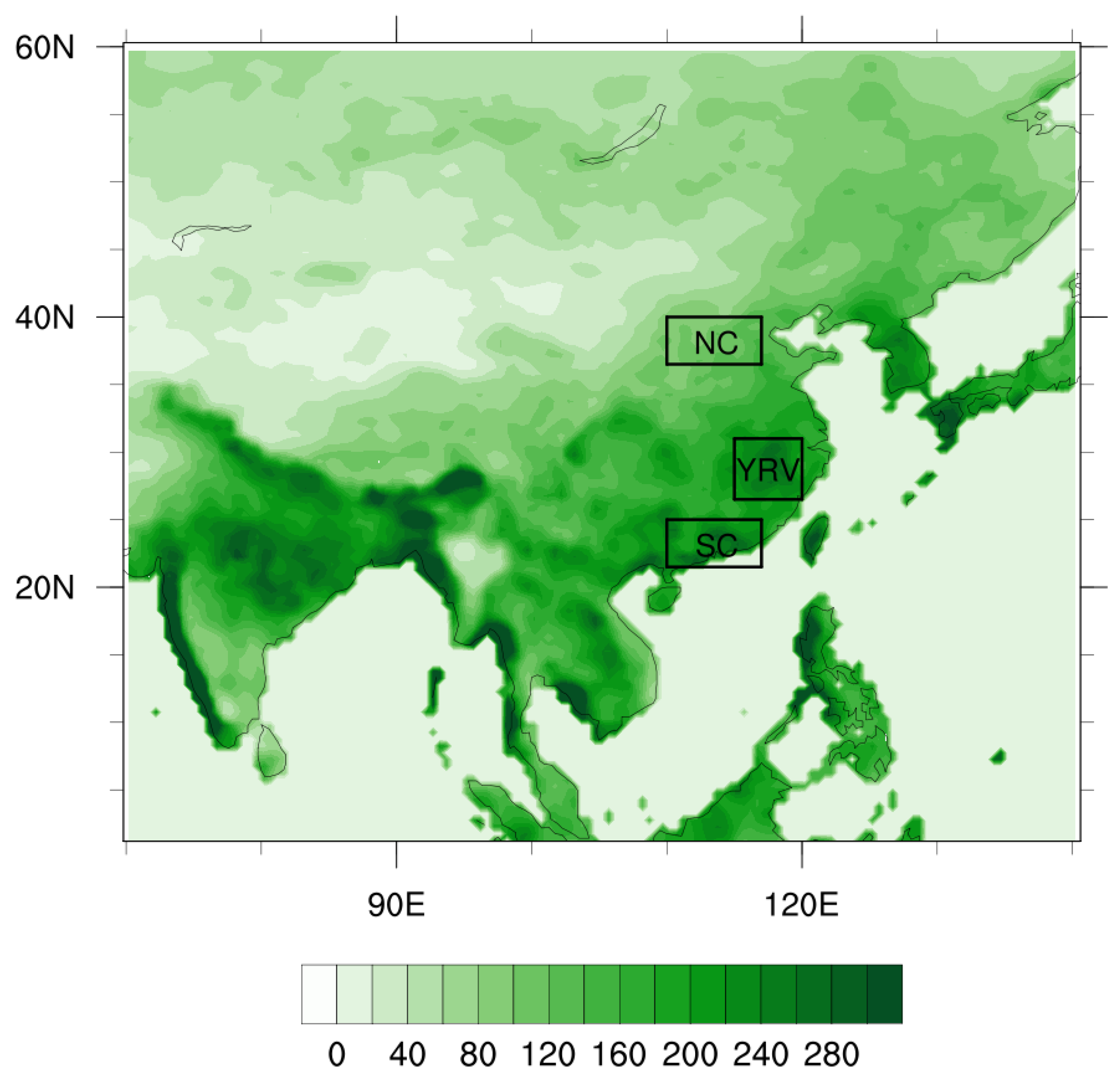
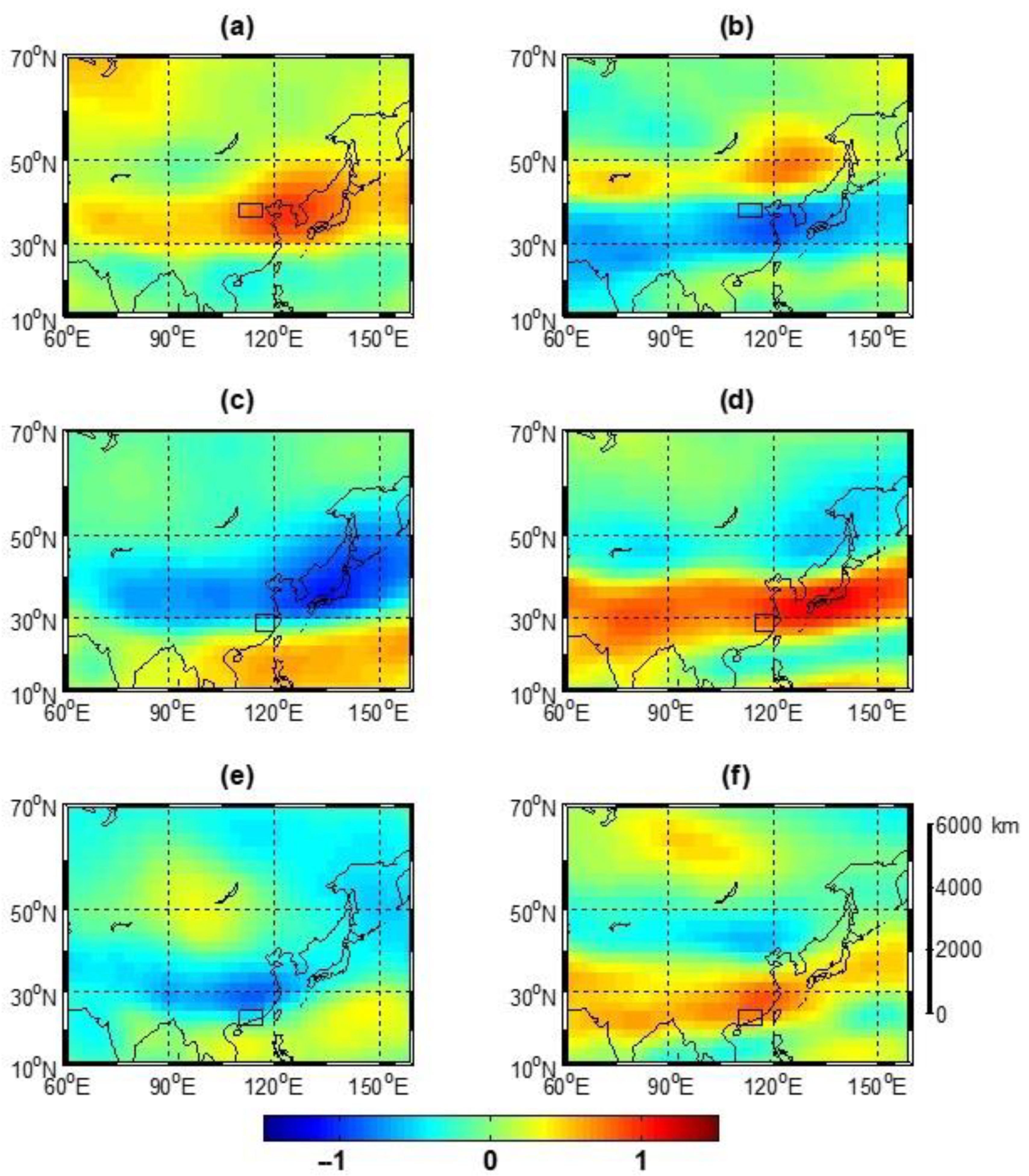

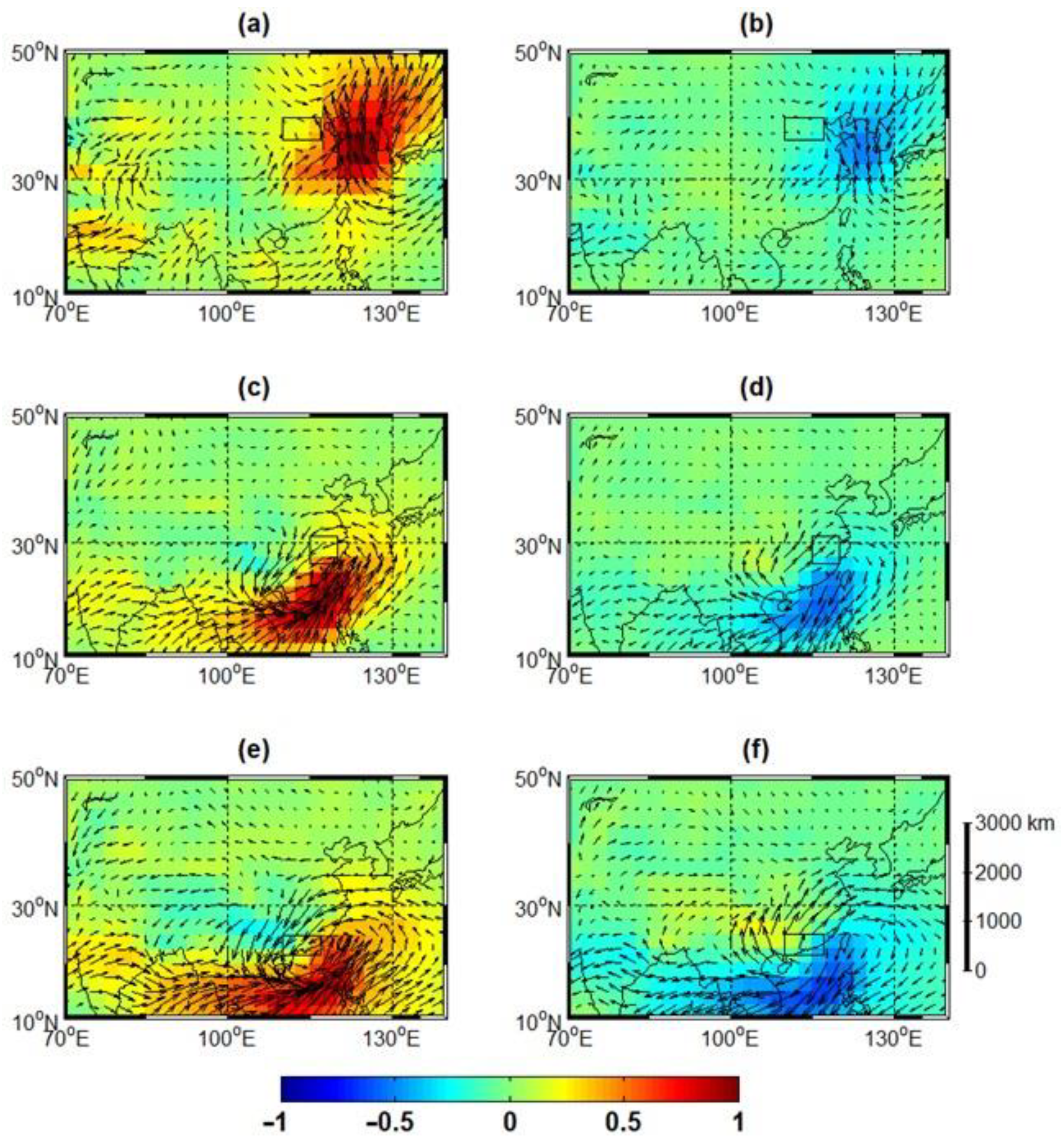
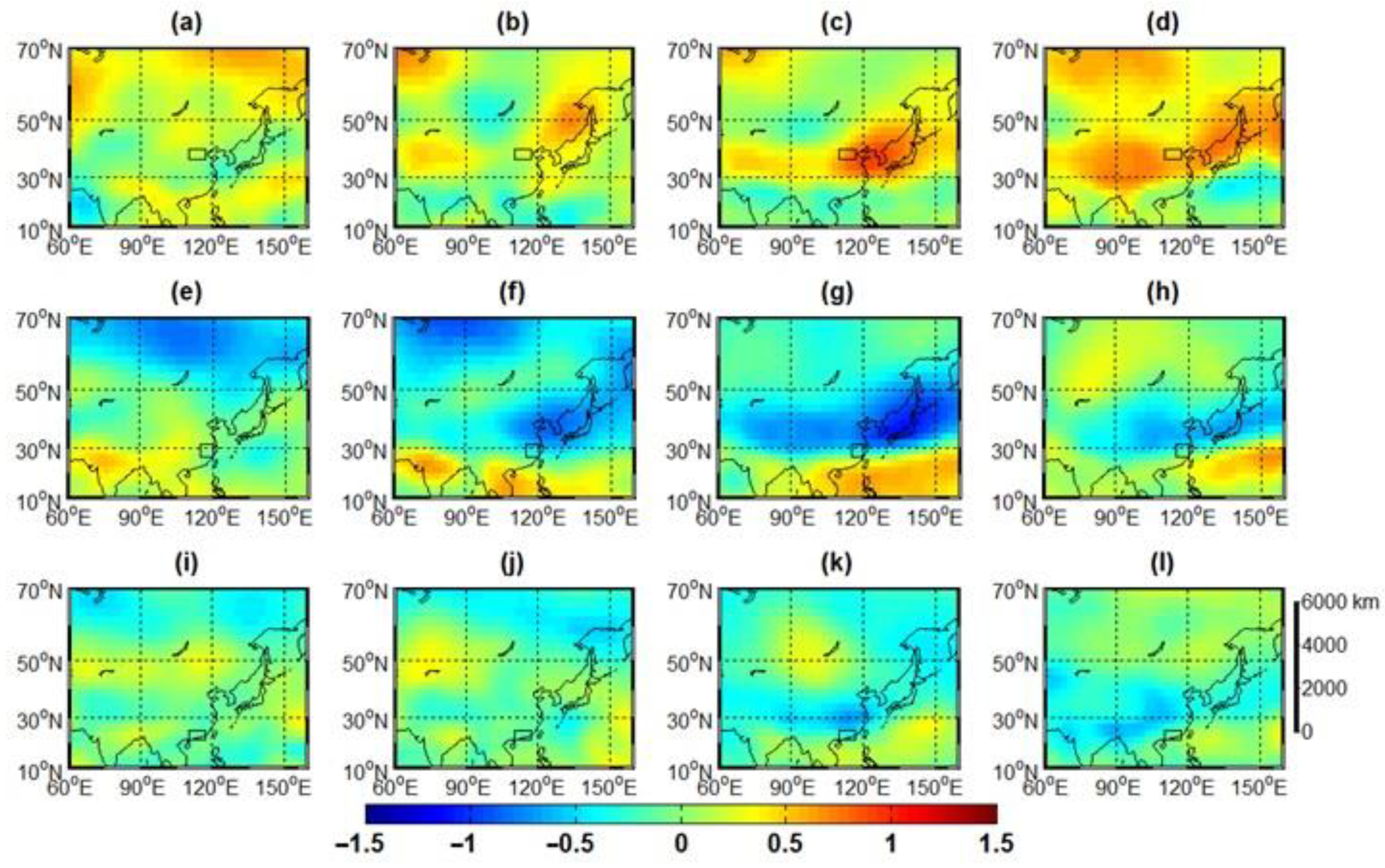
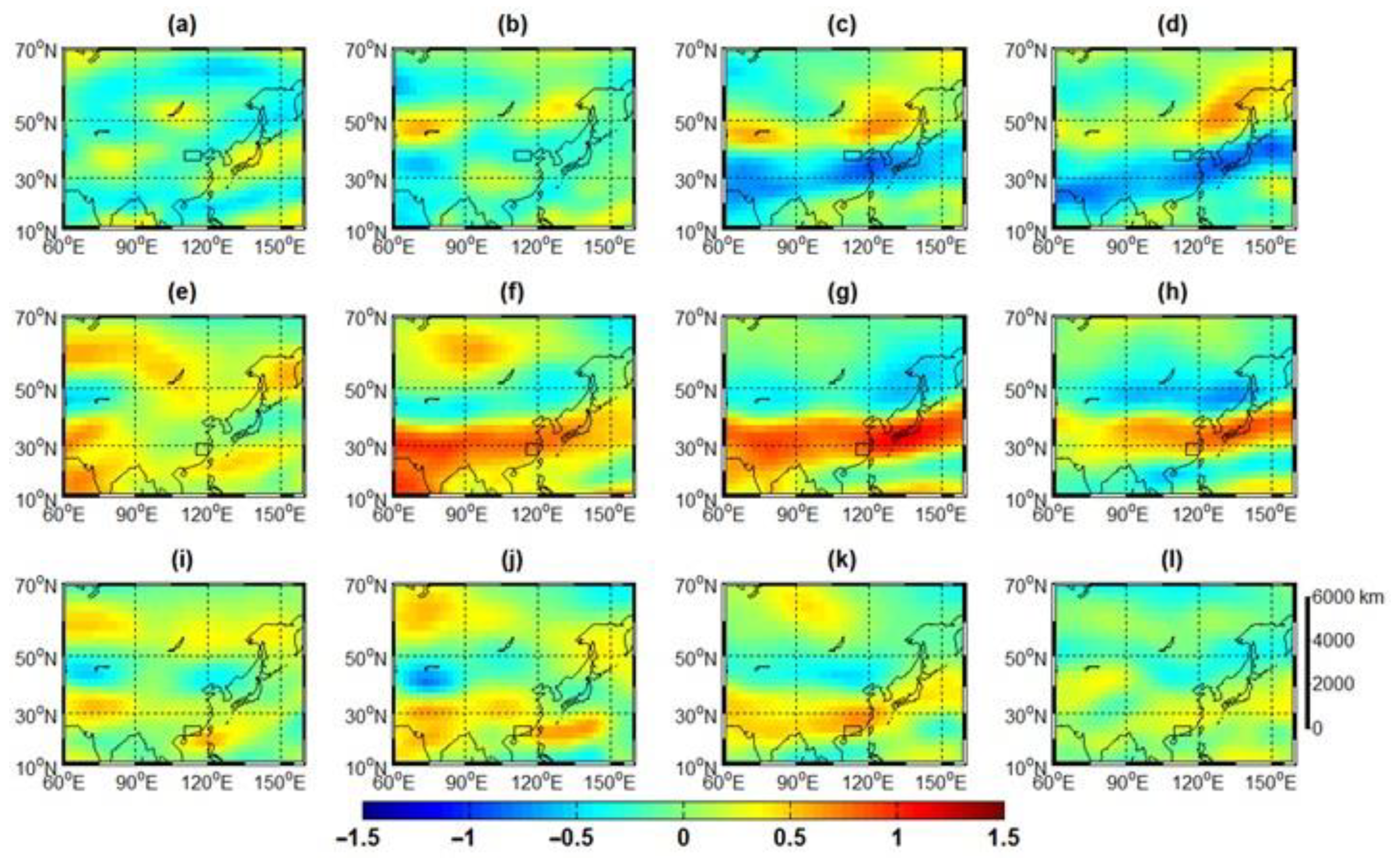
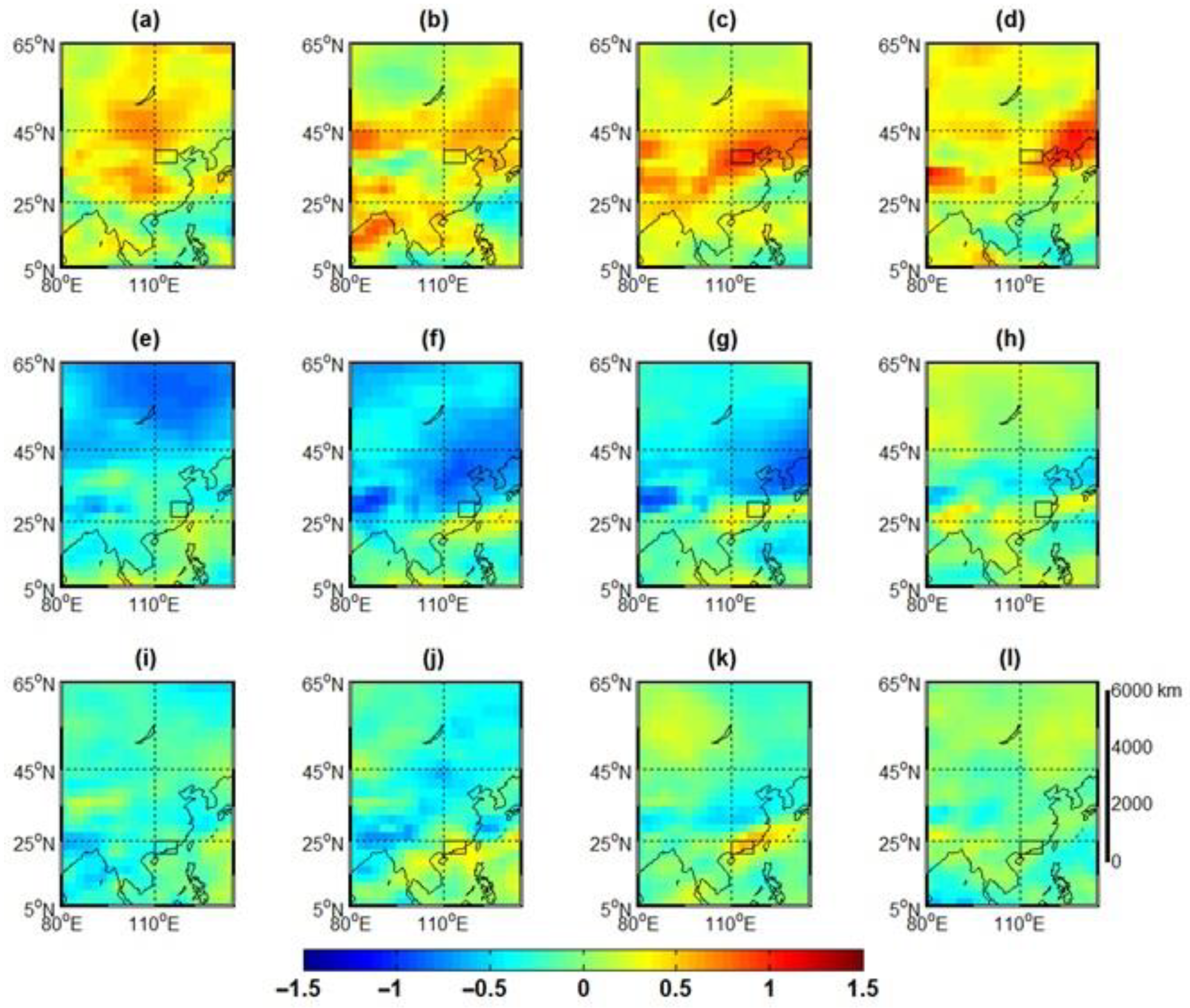

Publisher’s Note: MDPI stays neutral with regard to jurisdictional claims in published maps and institutional affiliations. |
© 2022 by the authors. Licensee MDPI, Basel, Switzerland. This article is an open access article distributed under the terms and conditions of the Creative Commons Attribution (CC BY) license (https://creativecommons.org/licenses/by/4.0/).
Share and Cite
Sun, X.; Wang, Y. Comparisons of the Synoptic Characteristics of 14-Day Extreme Precipitation Events in Different Regions of Eastern China. Atmosphere 2022, 13, 1310. https://doi.org/10.3390/atmos13081310
Sun X, Wang Y. Comparisons of the Synoptic Characteristics of 14-Day Extreme Precipitation Events in Different Regions of Eastern China. Atmosphere. 2022; 13(8):1310. https://doi.org/10.3390/atmos13081310
Chicago/Turabian StyleSun, Xinyu, and Yongdi Wang. 2022. "Comparisons of the Synoptic Characteristics of 14-Day Extreme Precipitation Events in Different Regions of Eastern China" Atmosphere 13, no. 8: 1310. https://doi.org/10.3390/atmos13081310
APA StyleSun, X., & Wang, Y. (2022). Comparisons of the Synoptic Characteristics of 14-Day Extreme Precipitation Events in Different Regions of Eastern China. Atmosphere, 13(8), 1310. https://doi.org/10.3390/atmos13081310





